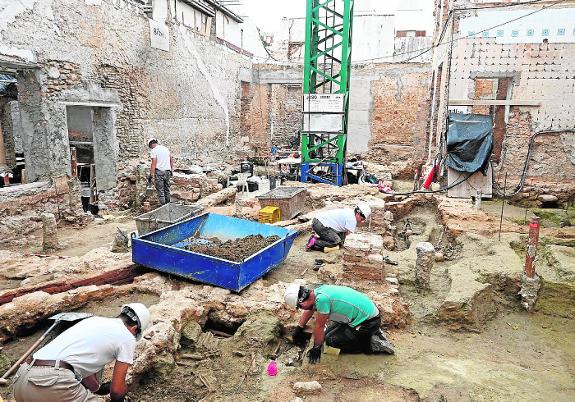Works at La Fonda hotel have uncovered the remains of an entire 16th-century church
Archaeologists have also found 18th-century frescoes which will be removed and preserved, and items created by Moorish goldsmiths
Héctor Barbotta
Jueves, 10 de diciembre 2020, 18:44
Last summer archaeologists excavating beneath the old La Fonda hotel in Marbella discovered a necropolis dating back to the 16th century and the walls of old San Sebastián church, whose location had never been ascertained. Now, other items have been found which also provide essential information about the history of Marbella. They include the front of the church, niches which had been built over time, and some of the chapels.
This was what historians call a Reconquest church, built by the Catholic Monarchs after the expulsion of the Moors as they imposed a new religion on the country. Documents suggest that it was originally a chapel dedicated to San Sebastián and later changed to the Virgen de los Remedios, which was abandoned in the early 19th century.
The main chapel had been decorated and samples of its frescoes are currently being analysed by a laboratory. The dome includes painted angels, flower motifs and other elements relating to the Virgen de los Remedios. These appear to date from the 18th century, when the church was enlarged.
The architect leading these works, Miguel Vila, says all these features will be incorporated into the hotel which is to be built on this site, and will be part of the heritage of the town. Construction work had to come to a halt when these historic remains came to light.
The archaeologists have found human remains in mass graves during these excavations, as well as funerary items and tools from the medieval period, some of which are still in one piece and have great historical value.
First evidence of the Nasrid presence
-
For historian Francisco Moreno, the findings beneath the old La Fonda hotel are providing major information about the history of Marbella, "not just San Sebastián church and the evidence that burials had taken place on this site, but the presence of Almohad and Nasrid structures as well," he says. Until now there had been no information about the Andalusian period in the north of Marbella Old Town. "This has shown that there was probably an area outside the walls used for agriculture, ceramics and a tannery, because items relating to all of these have been found. It means that what could be no more than a hypothesis before is now being shown to be correct," he says.
Historian Francisco Moreno, who is working alongside Vila, says this is proving to be one of the two most important discoveries in Marbella in the past 20 years; the other was the Castelum Romano.
Although no evidence has been found to suggest that there was a Muslim place of worship in this area, Moreno says the Reconquest churches dedicated to San Sebastián were usually built on sites where mosques used to stand.
The front of the building and two of the inner walls contained paintings of fake architecture and these will be preserved. Miguel Vila says they provide valuable information about the way this old part of Marbella would have looked, two centuries ago.
